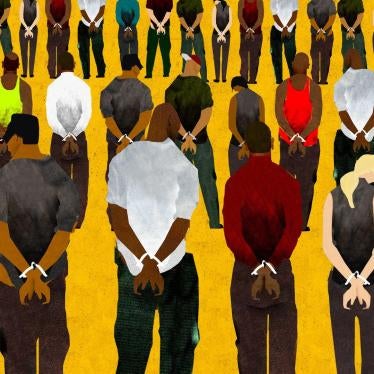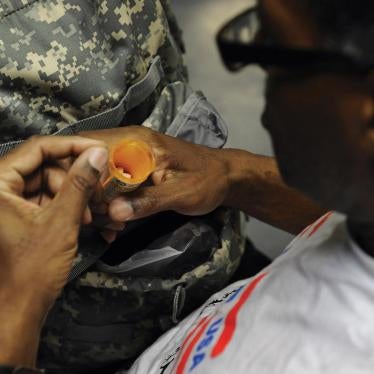Human Rights Watch submits the following statement to the United States Sentencing Commission in response to the Commission’s May 6, 2014 request for comments on whether its recent amendment to lower the base offense levels keyed to drug quantities should be made retroactive. We strongly support retroactive application. There is no justification for requiring formerly sentenced federal inmates to continue serving prison terms imposed under a sentencing structure the Commission has rightly discarded.
The Commission voted unanimously in favor of what is commonly referred to as its “all drugs minus two” amendment, on April 10, 2014. The amendment reduces by two the base offense levels assigned to the drug quantities that trigger the statutory five- and ten-year mandatory minimum sentences and reduces most other offense levels accordingly. The practical result of the amendment is that sentences for a preponderance of federal drug trafficking defendants (approximately 70 percent) would decrease an average of 11 months. Human Rights Watch submitted comments supporting the amendment in March of this year.
We now urge the Commission to make the “all drugs minus two” amendment fully retroactive for three key reasons. First, human rights principles—which reflect basic notions of fairness and considerations of justice—support the retroactive application of laws that reduce sentences. Second, such retroactive application is particularly important when the previously required applicable ranges are widely recognized as having been excessive because they were pegged to mandatory minimums that are unduly severe, as the Commission itself has recognized. And finally, these disproportionately severe sentences have been imposed primarily on people of color because they constitute the preponderance of all federal drug trafficking defendants. Retroactive application of this amendment will reduce the length of sentences disproportionately borne by racial and ethnic minorities, and hence be more consistent with goals of the International Convention on the Elimination of All Forms of Racial Discrimination, to which the United States is a party.
Retroactivity and Human Rights
Human rights law recognizes the importance of retroactive application of new laws that reduce sentences. Under article 15 of the International Covenant on Civil and Political Rights, to which the United States is a party, if “subsequent to the commission of the offence, provision is made by law for the imposition of the lighter penalty, the offender shall benefit thereby.”[1] Retroactivity may be particularly important in the pursuit of fairness and justice when the previously imposed sentences are widely recognized as disproportionately severe.
While the amended guideline ranges, in our judgment, remain excessive for most drug offenders, they nonetheless reduce by two levels the previously applicable ranges, a modest but nonetheless welcome improvement in federal drug sentencing.[2] We strongly support the lower sentences for future defendants because of the amendment, but are equally strong in our belief that already sentenced persons should be able to seek resentencing to enable them to benefit from lower sentences more proportionate to their offense. As Judge Irene Keeley testified before the Committee in June, “If the reasons that the amendment is being reduced suggest that… the former guideline needed an amendment then there didn’t seem to be a logical reason why those who are currently incarcerated shouldn't benefit from that same reasoning.”[3]
Congress recognized that considerations of fairness might warrant retroactive application of sentencing guideline reductions and required the Commission to consider whether amended guidelines should be applicable retroactively to those already sentenced.[4] The Commission should not shy away from using its authority to make guideline reductions retroactive. It need not require offenders to fully serve unjust sentences simply because they “lost on temporal roll of the cosmic dice” and were sentenced under an unfair structure.[5] Failing to make the amendment retroactive would deprive some 51,141 offenders of the ability to seek a reduction to sentences imposed under the old guidelines.[6]
If the Commission decides its amendment should be retroactive, then the sentencing courts will have the authority to consider requests from already sentenced offenders to reduce their sentences in accordance with the new lower sentencing ranges.[7] The legislative history to 18 USC 3582(c)(2) refers to this availability of retroactive application of reductions as a “safety valve.”[8] Congress recognized that such a safety valve “keeps the sentencing power in the judiciary where it belongs, yet permits later review of sentences in particularly compelling situations.”[9]
We think the possibility of mitigating sentences that are now recognized as unduly harsh is exactly the kind of compelling situation the courts should be able to consider – and they can only do so if the Commission makes the amendment retroactive. Current offenders that would be eligible to petition for re-sentencing if the amendment is made retroactive are serving sentences of more than ten years (125 months), on average. If the courts were to grant the full reduction possible in each case, the projected new average sentence for these offenders would be 102 months, a reduction of 23 months or 18.4 percent of their current sentences. As Mary Price, general counsel of FAMM, eloquently summarized in her testimony to the Commission, a two year sentence reduction may not sound like much but will have a dramatic beneficial impact on the lives of the offenders and their families. [10]
Disproportionality
Human rights and fundamental criminal justice principles dictate that punishment should be proportionate to the offense and the individual’s blameworthiness and no greater than necessary to further the purposes of punishment. Our support for the “all drugs minus two” amendment stemmed from our conviction that the current federal sentencing guidelines resulted in sentences for drug offenders that all too often were disproportionately severe relative to their conduct and culpability. Although a far more thorough overhaul of the sentencing guidelines is needed to address disproportionately severe sentences for federal drug offenders, the amendment was nonetheless valuable as a modest step in reducing that disproportionality.
The origin of the “all drugs minus two” amendment was an attempt by the Commission to address overcrowding of the federal prison system, driven primarily by drug prosecutions.[11] The average federal drug sentence has increased 250 percent since 1987 when the Sentencing Commission first published its guidelines. As federal drug sentences have increased, so have the number of people imprisoned for drug offenses. Between 1980 and 2014, the number of incarcerated federal drug defendants soared from 4,749 to 100,888 —an astonishing 2,024 percent.[12] As of April 26, 2014, just under half—49.9 percent—of all federal prisoners were in prison for a drug offense.[13] In fiscal year 2013 alone, 25,000 men and women were convicted of federal drug crimes.[14]
The dramatic increase in the number of people imprisoned for federal drug offenses and the increase in length of drug sentences might not be so troubling if the drug offenders in federal prison were primarily violent kingpins and major traffickers. But, in fact, as Commission statistics have shown, convicted federal drug defendants are most commonly couriers (23 percent), wholesalers (21.2 percent) and street-level dealers (17.2 percent).[15] Nine out of ten federal drug defendants are in the lower or middle tiers of the drug business.[16] Almost half (49.6 percent) of all federal drug offenders imprisoned in Fiscal Year 2013 fell under the lowest criminal history category (zero or one criminal history point under the federal sentencing guidelines).[17] And 83.8 percent of federal drug offenders during the same period were found to not have a weapon involved in their crime.[18]
Racial disparities
The Commission notes that three out of four people that would be eligible to seek relief under the retroactive application of the “drugs minus two” amendment are people of color (15,600 African Americans and 22,224 Latinos).[19] This is not surprising, given that people of color constitute the great preponderance of those serving time for federal drug offenses. Extensive research has shown that the higher rates of minority incarceration for drug offenses are not a reflection of higher rates of drug offending conduct, but as a result of law enforcement priorities and patterns.[20] African Americans are arrested for drug offenses at a much higher rate than whites.[21] Though 13 percent of the population, they constitute 26.5 percent of all drug offenders convicted in federal court.[22] Latinos comprise 17 percent of the population but 47.9 percent of all drug offenders convicted in federal court. According to Sentencing Commission data, the average sentence for African American drug offenders was much higher than for whites: 92 months compared to 67 months.
Commissioner Saris captured the racial component of US drug enforcement in a recent speech at Georgetown University Law Center:
[M]ass incarceration of drug offenders has had a particularly severe impact on some communities in the past 30 years. Inner-city communities and racial and ethnic minorities have borne the brunt of our emphasis on incarceration. Sentencing Commission data shows that Black and Hispanic offenders make up a majority of federal drug offenders. In some communities, large segments of a generation of people have spent a significant amount of time in prison. While estimates vary, it appears that Black and Hispanic individuals are disproportionately under correctional control as compared to population demographics. This damages the economy and morale of communities and families as well as the respect of some for the criminal justice system.[23]
International human rights law prohibits racial discrimination regardless of intent. Under the International Convention on the Elimination of All Forms of Racial Discrimination (ICERD), policies or practices that have “the purpose or effect” of restricting rights on the basis of race are discriminatory.[24]
Reducing excessively severe long sentences imposed overwhelmingly on African American and Latino federal drug offenders will not remedy the unwarranted racial disparities in the incarceration of drug offenders. Addressing those disparities falls outside the Commission’s purview. But the Commission can and should seek to mitigate federal drug sentences that are borne disproportionately by African Americans and Latinos. Even a slight reduction in the guideline sentencing ranges they confront will help alleviate the impact of the incarceration disparity.
We agree with the following testimony presented to the Commission:
The damaging social effects of mass incarceration and long prison terms are concentrated in Black and Hispanic communities. Some of those effects could be ameliorated if individuals were allowed to return home earlier to their families and communities. To keep thousands of inmates in prison, after concluding that a lesser sentence is sufficient to serve the purpose of sentencing, would perpetuate the systemic bias underlying the criminal justice system and would “obliterate[] most Americans’ sense of justice.”[25]
The Commission has taken a partial step in this direction by promulgating its “all drugs minus two” amendment. But it should not just amend its guidelines to address discriminatory effects prospectively. By making the amendment retroactive, it can mitigate a discriminatory effect upon minority communities that has already occurred.
Full retroactivity
The Commission should make the “all drugs minus two” amendment fully retroactive. We urge it to reject the Department of Justice’s call for categorical exclusions to eligibility for retroactive relief.
In its testimony to the Commission on June 10, the Justice Department proposed a partially retroactive application, limiting potential relief to offenders in criminal history categories I or II who had not received a 924(c) firearm enhancement or a guideline enhancement for possession of a dangerous weapon, threat or use of violence, aggravating role in the offense, or obstruction of justice.[26] The Department offers two discrete public safety grounds to justify these exemptions: first, it suggests that the resources necessary for reviewing requests for sentence reduction will divert prosecutors and others from “working on cases that are necessary to keep our communities safe.” [27] Second, it suggests many of the otherwise eligible drug offenders are too dangerous to be released before fully serving their sentences so they should be categorically exempted.
We disagree with both arguments. We note that both consist primarily of assertions for which the Justice Department has not provided evidence. Moreover, such evidence as exists is contrary to its position.
With regard to its argument regarding the resources required to make the amendment fully retroactive, the Department has in effect thrown up its hands because of the number of people who might be eligible for a sentence reduction. It insists public safety will be harmed if prosecutors are diverted from pursuing new cases, rather than remedying unfairness in old cases. We do not know whether in fact there would be any tangible harm to public safety from having prosecutors work on case reviews instead of, for example, pursuing charges against more drug offenders.[28] More importantly, the Justice Department is far too willing to sacrifice fairness for expediency. Instead of committing to working with other stakeholders to develop ways to streamline the process to make it less resource intensive, the Justice Department wants the Commission to winnow the number of potentially eligible offenders by excluding certain groups.
The Commission should not be persuaded by the resource burden argument. As Judge Reggie Walton testified before the Commission in 2007 when addressing the crack guidelines, “Retroactivity was not intended as an instrument to make isolated or minor adjustments; rather, it was meant as a means to make sweeping and serious change.”[29] Indeed, the magnitude of the numbers who might be eligible for relief under full retroactivity is itself an argument for the importance of such retroactivity – tens of thousands of people were sentenced under an unfair structure. None of them should be required to serve unduly long sentences to full term if courts might conclude that a shorter sentence adjusted under retroactive application of the new guidelines would serve the purposes of punishment without compromising public safety.
In the past, the Commission has considered procedures to reduce the administrative burdens that are an unavoidable component of retroactive application. For example, Judge Walton suggested that the Commission consider issuing a policy statement that narrowed the range of issues to be considered at resentencing hearings.[30] Witnesses before the Commission have noted that in the past, prosecutors, judges, the defense bar, and probation and supervisory personnel have worked together with remarkable efficiency to handle the number of applications for reduced sentences because of guideline changes. There is no reason to believe they cannot do so again.
The second public safety argument the Justice Department makes for categorical exclusions from retroactive application of the amendment is even more unpersuasive. It suggests offenders within the proposed excluded categories are “dangerous.” But the categories are not only bad proxies for dangerousness, they are misleading. There is no basis for the Justice Department’s argument that anyone in criminal history category three and above is de facto dangerous—offenders in criminal history category three can be small time repeat offenders, for example. Categorical exclusions on the basis of gun enhancements would sweep up offenders who received the enhancement solely because of weapon possession by a co-defendant or co-conspirator. It is also something of a puzzle why the Justice Department now claims these categories include dangerous offenders but it did not urge an exclusion of these categories from the original guideline amendment. As Judge Breyer questioned during the Commission’s hearing, if it is safe to apply the lower amended guidelines to an offender who is sentenced in the future, why is it not safe to give an already sentenced offender in those categories the benefit of the lower guidelines?[31] The Justice Department representative at the hearing was not able to provide a direct answer to that question.
The public safety argument is also undercut by the Commission’s own data on recidivism. Drug offenders whose sentence lengths were reduced pursuant to retroactive application of the 2007 crack cocaine guideline amendment did not have higher recidivism rates than those who served their full sentence. The lack of a statistical difference in recidivism rates for the two groups applied even for more serious offenders.[32] As Judge Keeley indicated during the Commission’s hearing, sentence length is not what prevents recidivism, and longer sentences for drug offenders do not protect public safety. Public safety is better served by proper programming while offenders are incarcerated and effective supervision and assistance when they are released, to address factors that lead to recidivism.[33]
We note finally, as many others have, that permitting retroactive application of the amendment does not mean that all eligible offenders will be granted a shorter sentence. In making a decision on the request for a reduced sentence the courts are required to carefully weigh a range of sentencing factors specified by Congress, including factors related to public safety risks should the offender be released.[34] The Commission itself has also instructed the courts that in considering whether to grant a reduced sentence based on retroactive application of amended guidelines, the courts should consider the “nature and seriousness of the danger to any person or the community” that might be posed by granting such a reduction.[35] We are confident the courts will review the merits of each request carefully and they will deny relief to those prisoners for whom early release is not warranted. The Department of Justice offers no evidence to the contrary.
Overall, the Department is being disingenuous in claiming that there is any kind of public safety rationale for limited retroactivity. It is simply arguing that drug offenders who have already been sentenced should suffer a penalty for committing their offense at the wrong time. It seems to prefer finality over fairness. The Commission should reject these arguments.
Conclusion
Human Rights Watch supported the “all drugs minus two” amendment and we were pleased to see it supported unanimously by the Commission. In our original comments, we also pushed the Commission to look further at more sweeping reforms to its guidelines with the goal of making them fairer and more proportional. Our support for “all drugs minus two” was both for prospective and retroactive application. Retroactive application would help to reduce unfair sentences that were both too long and have been borne disproportionately by members of minority communities. For these reasons, we urge the Commission to apply this amendment retroactively. We thank the Commission for the opportunity to provide comments on this proposal.
[1] While the United States has filed a reservation to this article, stating that US law generally applies the penalty in force at the time an offense is committed, the validity of the reservation has been called into question. See Connie de la Vega et al., Center for Law and Global Justice, University of San Francisco School of Law, “Cruel and Unusual: U.S. Sentencing Practices in a Global Context,” May 2012, http://www.usfca.edu/law/clgj/criminalsentencing_pr/ (accessed June 25, 2014).
[2] Our brief critique of drug sentencing guidelines is in Human Rights Watch, An Offer You Can’t Refuse: How US Federal Prosecutors Force Drug Defendants to Plead Guilty, December 5, 2013, https://www.hrw.org/reports/2013/12/05/offer-you-can-t-refuse, p. 34-42.
[3] United States Sentencing Commission (USSC), Public Hearing on Retroactivity of 2014 Drug Amendment, June 10, 2014, http://www.ussc.gov/sites/default/files/pdf/amendment-process/public-hea... (accessed June 25, 2014).
[4] 28 U.S.C. § 994(u) (1994).
[5] United States v. Fisher, 635 F.3d 336, 340 (7th Cir. 2011). The court expressed sympathy for appellants who were sentenced before the Fair Sentencing Act became effective, but held retroactivity was a matter for Congress to resolve. In the case of sentencing guidelines, in contrast to legislation, the Commission has the authority to remedy the cosmic role of dice.
[6] USSC, Memorandum from Office of Research and Data and Office of General Counsel to Chair Saris, Commissioners, and Kenneth Cohen, May 27, 2014, http://www.ussc.gov/sites/default/files/pdf/research-and-publications/re... (accessed June 25, 2014).
[7] 18 USC § 3582(c)(2). The Commission promulgated USSG §1B1.10 (Reduction in Term of Imprisonment as a Result of Amended Guideline Range) (Policy Statement) to implement 28 U.S.C. § 994(u) and to provide guidance to a sentencing court considering a motion for sentence reduction under 18 U.S.C. § 3582(c)(2).
[8] S. Rep. No. 225, 98TH Cong., 1ST Sess. 1983, 1983 WL 25404 (Leg.Hist.), http://www.fd.org/docs/select-topics---sentencing/SRA-Leg-History.pdf (accessed July 7, 2014) (another 'safety valve,' set forth in subsection (c)(2), permits the court to reduce a term of imprisonment, upon motion of the defendant or the director of the bureau of prisons or on its own motion, if the term was based on a sentencing range in the applicable guideline that was lowered by the sentencing commission after the defendant's sentence was imposed and if such a reduction is consistent with applicable policy statements of the sentencing commission).
[9] Ibid.
[10] Written statement of Mary Price, General Counsel, Families Against Mandatory Minimums to the United States Sentencing Commission, Public Hearing on Retroactive Application of 2014 Drug Guidelines Amendment, June 10, 2014, http://www.ussc.gov/sites/default/files/pdf/amendment-process/public-hea... (accessed June 25, 2014).
[11] Chief Judge Patti B. Saris, Chair, “Remarks for Public Meeting,” United States Sentencing Commission, April 10, 2014,
http://www.ussc.gov/sites/default/files/pdf/amendment-process/public-hea... (accessed June 25, 2014).
[12] The Sentencing Project, “The Expanding Federal Prison Population,” March 2011, http://www.sentencingproject.org/doc/publications/inc_FederalPrisonFacts... (accessed May 27, 2014), p. 2; and Federal Bureau of Prisons, “Offenses,” April 26, 2014, http://www.bop.gov/about/statistics/statistics_inmate_offenses.jsp (accessed May 27, 2014).
[13] See Federal Bureau of Prisons, “Offenses,” May 24, 2014, http://www.bop.gov/about/statistics/statistics_inmate_offenses.jsp (accessed July 7, 2014).
[14] USSC, 2013 Sourcebook of Federal Sentencing Statistics (2013 Sourcebook), http://www.ussc.gov/research-and-publications/annual-reports-sourcebooks... (accessed June 25, 2014).
[15] The analysis was undertaken in 2010 based on a sample of drug offenders from 2009. According to the Sentencing Commission’s definitions, couriers transport or carry drugs using a vehicle or other equipment; street-level dealers distribute retail quantities (less than one ounce) directly to users; and wholesalers buy or sell at least one ounce or possess at least two ounces. USSC, “Report to the Congress: Mandatory Minimum Penalties in the Federal Criminal Justice System,” October 2011, http://www.ussc.gov/Legislative_and_Public_Affairs/Congressional_Testimo...(accessed March 17, 2014), p. 166-169.
[16] USSC, 2013 Sourcebook, http://www.ussc.gov/research-and-publications/annual-reports-sourcebooks..., Table 40: Role Adjustment of Drug Offenders in Each Drug Type. See USSC, “Guidelines Manual,” November 2013, http://www.ussc.gov/sites/default/files/pdf/guidelines-manual/2013/manua...(accessed May 22, 2013), Sec. 3B1.1 for an explanation of aggravated role sentence adjustment.
[17] USSC, 2013 Sourcebook, http://www.ussc.gov/research-and-publications/annual-reports-sourcebooks/2013/sourcebook-2013, Table 37: Criminal History Category Of Drug Offenders In Each Drug Type.
[18] Ibid, Table 39: Weapon Involvement Of Drug Offenders In Each Drug Type. For heroin-related offenses, 86% did not involve a weapon; for marijuana-related offenses, 89.8% did not involve a weapon.
[19] USSC, Memorandum from Office of Research and Data and Office of General Counsel to Chair Saris, Commissioners, and Kenneth Cohen, May 27, 2014, http://www.ussc.gov/sites/default/files/pdf/research-and-publications/re....
[20] See Jamie Fellner, “Race and Drugs,” in Oxford Handbook of Ethnicity, Crime, and Immigration, ed. Sandra M. Bucerius and Michael Tonry (Oxford: Oxford University Press, 2013), https://www.hrw.org/news/2013/10/25/race-and-drugs (accessed July 7, 2014). In absolute numbers, many more whites than African Americans use illicit drugs. The best available evidence indicates that African Americans are no more likely than whites to sell drugs. In absolute numbers, there are many more white than black drug dealers. Most experts agree that the racial disparities in drug law arrests and incarceration reflect the concentration of drug law enforcement activities in inner city areas with high minority populations. But law enforcement’s strategic choices in turn reflect the longstanding influence of race on how the United States has defined the drug problem.
[21] Ibid.
[22] USSC, 2013 Sourcebook, http://www.ussc.gov/research-and-publications/annual-reports-sourcebooks/2013/sourcebook-2013, Table 34: Race Of Drug Offenders In Each Drug Type.
[23] Chief Judge Patti B. Saris, Chair, USSC, Speech to Georgetown University Law Center, “A Generational Shift For Drug Sentences,” March 26, 2014, http://www.ussc.gov/sites/default/files/pdf/training/online-learning-cen... (accessed June 25, 2014).
[24] The Committee on the Elimination of All Forms of Racial Discrimination, the body tasked with overseeing ICERD compliance, has recommended that state parties pay close attention to factual indicators that would reveal impermissible racial discrimination regardless of intent. These include looking at proportionately higher crime rates involving persons of color, with particular attention to drug related crimes, and harsher sentencing against persons of color. Committee on the Elimination of All Forms of Racial Discrimination, General Recommendation 31, UN Doc. CERD A/60/18(SUPP).
[25] Written statement of Sarah Gannett on behalf of the Federal Public and Community Defenders before the United States Sentencing Commission, Public Hearing on Retroactivity of the 2014 Guideline Amendments to §2D1.1 and §2D1.11, June 10, 2014, http://www.ussc.gov/sites/default/files/pdf/amendment-process/public-hea... (accessed July 7, 2014), citing Dorothy Roberts, “The Social and Moral Cost of Mass Incarceration in African American Communities,” Stanford Law Review, vol. 56 (2004), 1305.
[26] Statement of Sally Quillian Yates, United States Attorney, Northern District of Georgia, before the United States Sentencing Commission, Hearing on Retroactive Application of the Pending Drug Guideline Amendment to the Federal Sentencing Guidelines, June 10, 2014, http://www.ussc.gov/sites/default/files/pdf/amendment-process/public-hea... (accessed July 7, 2014).
[27] Ibid.
[28] Drug offenders constitute close to one-third of convicted federal defendants each year, and most of them are low level offenders. USSC, 2013 Sourcebook, http://www.ussc.gov/research-and-publications/annual-reports-sourcebooks..., Table 12: Offenders Receiving Sentencing Options in Each Primary Offense Category; Table 40: Role Adjustment of Drug Offenders in Each Drug Type.
[29] Testimony of Judge Reggie B. Walton Presented to the United States Sentencing Commission on November 13, 2007, on the Retroactivity of the Crack-Powder Cocaine Guideline Amendment, November 13, 2007, http://www.ussc.gov/sites/default/files/pdf/amendment-process/public-hea... (accessed July 7, 2014).
[30] Ibid. See also the list of procedural recommendations made by the Judicial Conference when the Commission was considering retroactivity of its “crack minus two” amendment in 2007: Paul Cassel, Committee on Criminal Law of the Judicial Conference of the United States, Letter to Chairman Ricardo H. Hinojosa, United States Sentencing Commission, November 2, 2007, http://sentencing.typepad.com/sentencing_law_and_policy/files/clc_letter... (accessed July 7, 2014).
[31] USSC, Public Hearing on Retroactivity of 2014 Drug Amendment, June 10, 2014, http://www.ussc.gov/sites/default/files/pdf/amendment-process/public-hea..., p. 144.
[32] USSC, “Recidivism Among Offenders Receiving Retroactive Sentence Reductions: The 2007 Crack Cocaine Amendment,” May 2014, http://www.ussc.gov/sites/default/files/pdf/research-and-publications/re... (accessed July 7, 2014).
[33] USSC, Public Hearing on Retroactivity of 2014 Drug Amendment, June 10, 2014, http://www.ussc.gov/sites/default/files/pdf/amendment-process/public-hea..., p. 66-67.
[34] 18 U.S.C. 3582(c)(2) directs the courts to apply the factors enunciated in 18 U.S.C. 3553(a).
[35] USSC, “Guidelines Manual,” November 2013, http://www.ussc.gov/sites/default/files/pdf/guidelines-manual/2013/manua..., Commentary, Sec. 1B1.10.







